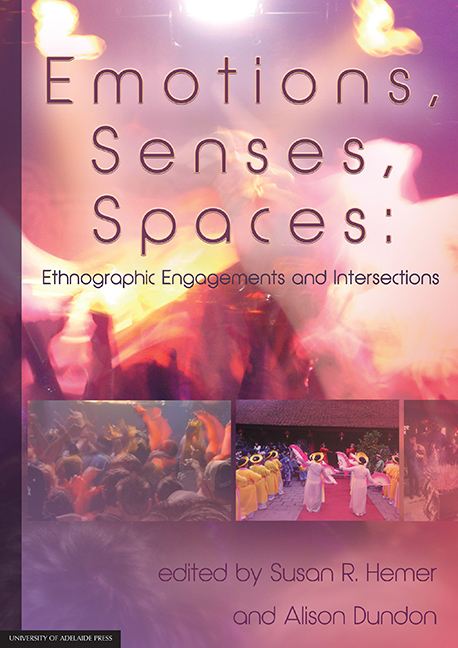Book contents
- Frontmatter
- Contents
- Biographies
- 1 Ethnographic intersections: Emotions, senses and spaces
- 2 ‘Dancing for joy’: Gender and relational spaces in Papua New Guinea
- 3 Creating the right ‘vibe’: Exploring the utilisation of space at Hip Hop concerts in Adelaide and Melbourne
- 4 Pontic dance: Feeling the absence of homeland
- 5 Emotional actors/Affective agents: Interspecies edgework and sociotechnical networks in the Spanish bullfight from horseback (rejoneo)
- 6 Sensual feasting: Transforming spaces and emotions in Lihir
- 7 Anxious spaces: The intersection of sexuality, the senses and emotion in fieldwork in Nepal
- 8 Interrupted research: Emotions, senses and social space in (and out of) the field
- 9 Voices in the park: The composition of sacred space and public place
- 10 Ngadha being-in-common: Emotional attachment to people and place in Flores, Indonesia
- 11 Trust your senses: Growing wine and making place in McLaren Vale
1 - Ethnographic intersections: Emotions, senses and spaces
Published online by Cambridge University Press: 25 July 2017
- Frontmatter
- Contents
- Biographies
- 1 Ethnographic intersections: Emotions, senses and spaces
- 2 ‘Dancing for joy’: Gender and relational spaces in Papua New Guinea
- 3 Creating the right ‘vibe’: Exploring the utilisation of space at Hip Hop concerts in Adelaide and Melbourne
- 4 Pontic dance: Feeling the absence of homeland
- 5 Emotional actors/Affective agents: Interspecies edgework and sociotechnical networks in the Spanish bullfight from horseback (rejoneo)
- 6 Sensual feasting: Transforming spaces and emotions in Lihir
- 7 Anxious spaces: The intersection of sexuality, the senses and emotion in fieldwork in Nepal
- 8 Interrupted research: Emotions, senses and social space in (and out of) the field
- 9 Voices in the park: The composition of sacred space and public place
- 10 Ngadha being-in-common: Emotional attachment to people and place in Flores, Indonesia
- 11 Trust your senses: Growing wine and making place in McLaren Vale
Summary
In his book Paths toward a Clearing Jackson (1989) describes the Kuranko girls’ initiation rites that he witnessed in 1970:
Each night from the veranda of the house where I was staying I would watch the girls performing the graceful and energetic yatuiye and yamayili dances … With their hair specially braided and adorned with snail‑shell toggles and wearing brightly coloured beaded headbands, groups of girls passed from house to house around the village, dancing, clapping, and singing that their girlhood days were almost over. The daylight hours too were crowded with activities. Visitors poured into the village … all while the neophytes continued to circulate around the village in the company of indefatigable drummers … Then women performers danced before us too. One was dressed in men's clothes with a wild fruit hung from a chord across her forehead. She imitated the maladroit dance movements of men, her face expressionless, while other women surrounded her, clapping, singing, and laughing. (Jackson 1989:124‑5)
At the time Jackson puzzled over the meanings of the rites and, with great fervour, sought answers to the questions he posed about the rites, ‘decoding the ritual activities as if they were symbolic representations of unconscious concerns’ (125). Looking back, Jackson acknowledged that he assumed that there was a distinction to be made between pragmatic work and ritual activity, and that ritual could be analysed and interpreted outside of its action and experience. He wrote that the
quest for semantic truths also explained my inability to participate in the spirit of the performances and why I spent time asking people to tell me what was going on, what it all meant, as if the painted bodies and mimetic dances were only the insipid remnants of what had perhaps once been a symbolically coherent structure of myths and masks. (127)
In this later analysis, Jackson argued the need for a primary focus on experiential, sensory and bodily aspects of ritual and other forms of social action, and pointed to how ‘the body is the ground for what is thought and said’ (131).
- Type
- Chapter
- Information
- Emotions, Senses, SpacesEthnographic Engagements and Intersections, pp. 1 - 16Publisher: The University of Adelaide PressPrint publication year: 2016

